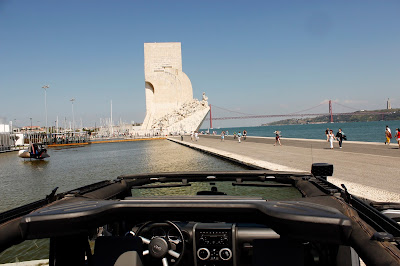The original building of the Discoveries that Cottinelli Telmo smiled and Leitão de Barros and Leopoldo de Almeida gave mental and plastic form, was erected in 1940 during the Portuguese World Exhibition. Originally consisted in its architectural part by a slight iron and cement structure, being in the gypsum sculptural composition consists of 33 figures, with the maximum figure the Infante D. Henrique.
- Commemorative Monument and evocative of Epic of the Portuguese Maritime Discoveries.
It is an ex-libris of Lisbon. It was a provisional draft of the architects Cottinelli Telmo (1897-1948) to which Leopoldo de Almeida (1898-1975) and Barros Leitão formed in iron and plaster. Commissioned by the Salazar regime for the Portuguese World Exhibition 1940, it was dismantled this template and made this replica concrete coated limestone rock in 1960, the year of commemoration of the 500th anniversary of the death of Infante D. Henrique.
Located on the edge of the river and even leaning on this, has 52 m of height and elevator that leads us to the 6th floor and then a climb stairs to the terrace where you can enjoy a fantastic panoramic view of the Tagus, the other "band "and the Empire Square / Jeronimos.
In the basement or lower floor has a temporary exhibition and conference room.
The monument is shaped like the prow of a stylized caravel c / o shield of Portugal and the sword of the Avis Royal House carved over the entrance.
He has sculpted 33 figures of our heroes linked to the discoveries, and the central figure of Infante D. Henrique (The Navigator - son of John I and booster maritime adventure of the people), which, with 9 m high, is at bow with a caravel in the hands. In two side ramps are 32 other figures of heroes and Portuguese navigators linked to the discoveries of secs. XV and XVI.
To highlight the figures of the poet Luis de Camões with a copy of the Lusíadas and painter Nuno Gonçalves with a palette.
On the pavement of the access yard, front of the building, is designed a Rose-of-Winds in marble and limestone IOLs, white, red and black, with 50 m ø, which was a gift from the Republic of South Africa. It has a planisphere of 14 m and a central map with ships, caravels, galleons and mermaids and tracing the routes of discovery and Portuguese expansion. The design is the architect. Cristino da Silva (1896-1976).
The 33 figures are:
West - On the left side (viewed from the front and rear-facing / bow)
Prince Pedro, Duke of Coimbra (son of King John I of Portugal); Dona Filipa of Lancaster (Queen, Mother of Infants, of John I woman); Mendes Pinto (writer and adventurer East); Frei Gonçalo de Carvalho (Dominican); Frei Henrique de Coimbra (Franciscan); Luiz Vaz de Camões (epic poet, the largest in Portugal); Nuno Gonçalves (painter); Gomes Eanes de Zurara (columnist); Covilhan (viageiro); Jácome de Mallorca (cosmógrafo); Pero Escobar (browser / pilot); Pedro Nunes (mathematical); Pero Alenquer (browser / pilot); Gil Eanes (browser); João Gonçalves Zarco (browser); Prince Fernando, (the Holy Infant, son of King John I of Portugal).
The center and the bow Infante D. Henrique.
East - the right side (facing the front and front / back bow)
Afonso V of Portugal (King); Vasco da Gama (browser / discoverer of the sea route to India); Afonso Baldaia (browser); Pedro Alvares Cabral (browser / discoverer of Brazil); Ferdinand Magellan (browser / Circum-navigation Travel); Nicolau Coelho (browser); Gaspar Corte-Real (browser / Labrador Peninsula); Martim Afonso de Sousa (browser); Barros (Cronista / Historian); Stephen da Gama (captain); Bartolomeu Dias (browser / discoverer of the Cape of Good Hope); Diogo Cao (browser); António de Abreu (browser); Albuquerque (Viceroy of India / governor); St. Francis Xavier (missionary / evangelist); Cristóvão da Gama (captain).
For more information please contact:
Mobile Phone - 00 351 918 206 330
Email - info@abctravel.pt
RNAAT 24/2016







No comments:
Post a Comment